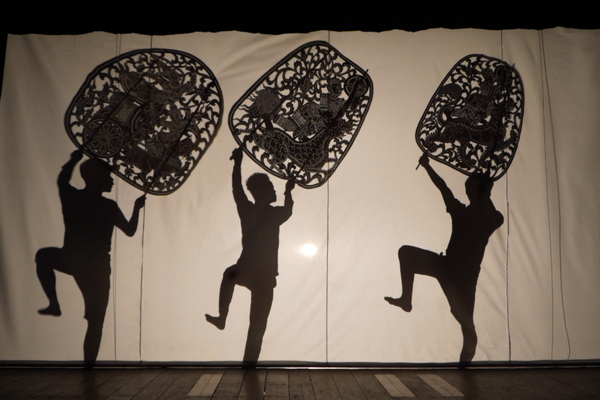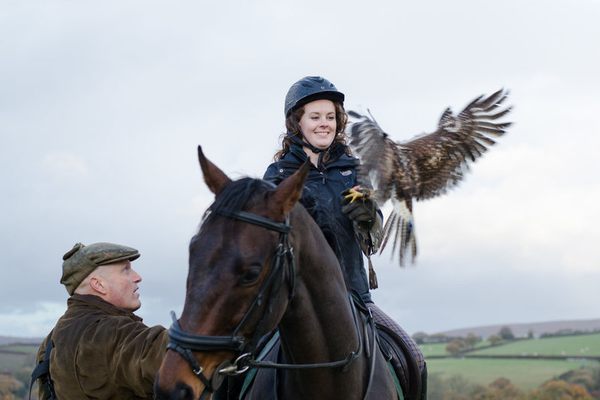The Gaelic World’s Last Great Bird Hunt
Just 10 men are permitted to hunt and pickle 2,000 young seabirds on a desolate island each year.
“It’s not all that tasty,” admits Murdanie Macleod, a merchant marine who lives just outside Ness, Scotland. “If it were available year round, I’d still only eat it once or twice.” The Northern Scottish delicacy called guga, or “gannet” in Gaelic, is a pickled, boiled seabird that has been variously described as tasting like salty goose or fishy duck—occupying the uneasy chasm between fish and fowl. Yet every August, “The Men of Ness” venture into one of the world’s most treacherous ocean passages to cull and pickle 2,000 young seabirds from a remote, rocky island.
But the future of the hunt is in doubt. Tens of thousands of animal-rights advocates have protested and petitioned against the practice, and in 2017, the small crew of dedicated hunters received death threats. The tradition’s survival is also threatened by the aging and shrinking population of Ness, the sole community where it now survives.
Much of the ire focuses on the hunters’ targets: three-month old gannets that are too young to fly. Fluffy, white newborns offer little muscle and too much fat, but once they’ve fledged, the sleek, blue-eyed fishers become lean and tough. The best-tasting guga are called “three tufts,” a reference to the downy feathers they shed before they’re ready to take flight. They are, proverbially, teenagers.

It makes for a rather odd, but no less celebrated meat. Donald S. Murray, a Ness native and author of Guga Hunters, tells a joke about its preparation: “You put a stone in a pot of water with the bird and set it to boil; when you can pierce the stone with a fork, the bird’s fully cooked.” The coarse meat does require prolonged boiling to soften it and remove the salty flavor stemming from a fish-based diet. “You’ve got to change the water, too” says MacLeod, who grew up eating guga and recalls the whole community awaiting the hunters’ return at Ness’s pier each year. “If you don’t, it’ll be mega salty.” Most wives demand their husbands cook the bird outside, the two agree.
A properly cooked guga, says Murray, tastes like “mackerel-flavored chicken.” Traditionally served with milk and potatoes, guga is eaten in September, after the hunters’ return. The taste is practically unknown outside of Ness.
As the home of the last guga hunters, Ness feels like a holdout in more ways than one. Its residents are some of the world’s last Gaelic-speakers—a language spoken by only one to two percent of the Scottish population. As the traditional tenured-farming system known as “crofting” sunsets, they’ve chosen to remain, even as others move to the mainland for job opportunities. In this context, guga stands out as one of the few singularly Gaelic culinary traditions remaining today in Scotland. The average Niseach, or Gaelic-speaking Ness resident, will only eat one or two of these odd, oily birds a year. Still, they are steadfast in keeping the hunt alive.

Hunting and eating guga is an ancient tradition, and part of the regional Gaelic identity. While the earliest written record of it on Ness’s go-to hunting ground—a desolate island called Sula Sgeir—is from 1549, hunting guga in this way is believed to date back thousands of years. Throughout Scotland, men hunted cliff-side gannet colonies, handing down techniques from father to son since time immemorial. “There is a repository of skills, a generational accumulation of knowledge, for how to survive in these areas, which itself is important,” says Murray. For the Nisich, hunting and eating guga became “a way of telling the outside world, ‘We’re not like you, we are distinctive.’”
The hunt first came under scrutiny in the early 1900s, amidst a flurry of concerns over British bird populations. With the extinction of several species of native birds in the preceding centuries, recreational hunting came into conservationists’ crosshairs, and the gannet population at one point tallied a mere 30,000 in Scotland. Prominent biologist Sir Julian Huxley, viewing the guga hunt, wrote to Geographical Magazine’s readers that he hoped “public opinion and the county council … [would] soon put a stop to this practice.” In 1954, the Royal Society for the Protection of Birds passed the Bird Protection Act, which banned the killing of seabirds, including guga, across the whole of the United Kingdom.
The law made one exception: Every year, 10 men from Ness could apply for permits to cull 2,000 guga on Sula Sgeir, a desolate island 40 miles north of their port community. It was a traditional hunting ground, but one of the hardest to reach. “It’s a very risky stretch of water [to get there],” says Murray. “You’ve got the depth of the Atlantic and the narrowness of the Minch [strait].” “The Men of Ness,” a tight-knit and selective group of Nisich licensed to hunt, haven’t missed a season since.

The exemption resembled those granted to Native American and Aboriginal Australians to hunt or harvest at-risk but traditional foods. “It’s the last stand in Scotland where Gaelic culture is strong. If it dies in Ness, it hasn’t got a chance anywhere else,” says MacLeod. Once spanning Ireland and most of Scotland, the Gaelic language and culture has slowly receded to the western fringes of those countries. Even into the 1970s, children could be punished for speaking Gaelic in school, part of a several-century history of British suppression of local culture and language. An ongoing spat over English versus Gaelic road signage embodies the modern cultural jostling. The road signs in Ness are all in Gaelic.
Sula Sgeir is now the site of an annual cultural pilgrimage, the last stand for the guga hunt. Surrounded by choppy waters, the jagged, uninhabited island atop sheer, 75-meter cliffs is dotted with the ruins of centuries-old stone bothies used by hunters of centuries’ past. Few have seen the island in person, and even fewer have set foot on it. Jaded by condemnation from outsiders, the hunters have silenced themselves to reporters and documentarians—even the man who skippers their boat each year declined to speak to me. The hunt itself has only been visually documented twice since 1954.

The BBC’s “The Guga Hunters of Ness” juxtaposes modern footage of the hunt with footage from 1959 to highlight the synchronicity of their technique, a testament to a timeless tradition. “Everything you do in Sula Sgeir has been done by people a long time,” said hunter John “Dodds” MacFarlane. “The same process: sleep in the same bothies, step on the same stone pathways. Nothing has changed.” He’s filmed as a toddler in black and white in 1959, helping his father push a wheelbarrow of gannet. He’s filmed again in 2011 as a middle-aged man in his final years as leader and defender of the guga hunt. “There’s a fierceness to his spirit. He is indomitable,” says Murray.
The hunt is arduous, and the men waste no time. After the eight-hour boat ride (once done in wooden rowboats), the men haul two weeks of water, food, clothes, tools, and tents on their backs up a steep cliffside from a small dinghy. Working in pairs, they catch the pre-fledged birds from the edge of precipitous cliffs: One traps each bird by the neck with a 10-foot pole before lifting it to his partner, who dashes the young bird’s head with a wooden stick. “From the time I catch it to the time it’s killed is about two, three seconds,” said MacFarlane. The men efficiently feather, scorch, brush, singe, de-bone, gut, salt, and pickle the finished product. The filletted birds are draped one over the other in a “pickle pile” to preserve in their own juices along a seaside cliff. “Each bird has to sort of [sit] on the next one to hold the pickle in the pile,” said MacFarlane.

The hunt functions as a retreat as well. There, the men speak Gaelic and huddle together in a small bothie to read from the Bible, also in Gaelic. As it was with generations of Presbyterian Nisich past, they bar themselves from working Sundays. On Sula Sgeir, the men reconnect with a culture they see receding in Ness, a community itself in recession: The population has halved in the last 50 years as young Nisich leave home for mainland opportunities.
It is a quiet tradition in Ness. Back at the pier when they return, the men divide the harvest and sell it to neighbors. While each roughly four-pound guga sold for £15 a piece this year, according to MacLeod, the men don’t do it for money. The profits often only cover the cost of taking two weeks off from work. Dividing a mere 2,000 guga in a community of just more than 1,000, the September tradition of eating guga in Ness is hard-earned, short-lived, and soft-spoken. “The story of the hunters themselves has never really been heard,” Murray told The Independent following the release of his book. “It has always been the animal rights groups calling the shots.”

In recent years, the internet has amplified outside opposition to guga hunting. MacLeod observed an uptick in activism from 2008 onwards, citing the advent of social media. With fears over extinction ameliorated (conservationists noted a sixfold gannet population increase across the 20th century), opposition has centered on the manner in which the birds were dispatched. Outrage over “birds [being] bludgeoned to death” can now be harnessed and directed. One petition tallied 70,000 signatures.
The opposition turned vitriolic after the Ness Football Club’s 2013 inaugural “World Guga Eating Championship,” whereby contestants raced to consume a half-gannet and a side of potatoes. (“It was done as a bit of a laugh,” says MacLeod.) “Stop this insane, monstrous … chick-eating contest! We are not in [the] middle ages anymore and idiotic things like this must be stopped!” read one petition. Derision hit a fever pitch when several hunters received death threats in 2017, traced to the Southeast of England.

“I don’t think he realizes how long it’d take to get up here,” says MacLeod of the threat. “And sure, he might kill a guy, but he’d never get off the island alive himself.” Murray describes the opposition as “a form of colonialism.”
The organization tasked with overseeing the gannets tells a less-alarming story. The Scottish Natural Heritage, who issue the Men of Ness their annual permits, recorded a modest 2.2% population increase in Sula Sgeir’s gannet population between 2004 and 2014. A spokesman for SNH also has said in a statement, “We are also satisfied that … the method used to dispatch the birds is not inhumane.” In 2010, a request from the Scottish Society for the Prevention of Cruelty to Animals to ban the hunt was denied by the Scottish government.
Year after year, the Nisich live with the hunt on a thread. The opposition remains entrenched, while Ness’s population continues to age. For MacLeod, however, one problem seems to solve the other. “As soon as someone says, ‘You have to stop your tradition,’ it’s like, ‘Get stuffed, now we’re definitely gonna keep doing it,’” he says. It’s certainly not just about pickled seabird for Murray. “The hunt is an act of defiance.”
Gastro Obscura covers the world’s most wondrous food and drink.
Sign up for our email, delivered twice a week.

















































Follow us on Twitter to get the latest on the world's hidden wonders.
Like us on Facebook to get the latest on the world's hidden wonders.
Follow us on Twitter Like us on Facebook